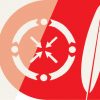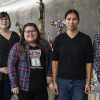The goal of the Program is to develop ways for Indigenous nations across Canada to represent their own history and culture in concert with cultural institutions.
The Indigenous Internship Program (IIP) offers professional and technical training for First Nations, Métis and Inuit participants. It is the first and most comprehensive program of its kind in Canada. The goal of the Program is to develop ways for Indigenous nations across Canada to represent their own history and culture in concert with cultural institutions.
Since 1993, the Program has welcomed interns from over 40 different Indigenous nations across Canada. Graduates have gone on to become role models and advocates in museum and cultural sectors.
The Program also works with a variety of affiliates and stakeholders such as Indigenous agencies, national museums, the federal government, local colleges and universities, provincial museums, Library and Archives Canada, the Canadian Conservation Institute, and the First Nations Confederacy of Cultural Education Centres, as well as Indigenous museums, libraries, cultural centres, and cultural tourism ventures.
Call for Proposals
Applications: Ongoing
The Canadian Museum of History’s Indigenous Internship Program will be accepting applications on an ongoing basis.
All applications should be received at least three months prior to the desired start date.
Timing
In order to ensure that the Program is as accessible as possible, we are pleased to offer a number of participation options, including in-person and hybrid, as well as part-time internships. Interested applicants will work with an Internship Coordinator to select the option that best suits them.
Eight-Month In-Person Option
From September to April
The first option is an eight-month, in-person and on-site internship. This internship takes place every year from September to April, with a two-week break for the holiday season. During the training year, candidates can undertake practicum assignments lasting four to five weeks in the areas of research, collections, conservation, exhibitions, public programs, corporate affairs, development, and museum services.
Please note that this option does require participants to be located in the Ottawa-Gatineau region throughout the duration of the internship.
Four-Month Hybrid Option
From January to April or from September to December
The internship will take place during a four-month period, either from January to April or from September to December. During those four months, participants will be working remotely from their preferred location on a research project based on a project proposal. They will be given access to the Museum’s network and database, and will have weekly meetings with an Internship Coordinator and a Mentor from the Museum to monitor their progress and to foster creativity.
On three separate visits of one week duration, participants will be brought to the Museum (all expenses paid). During the on-site portions of the internships, participants will have access to Museum resources in support of their specific project goals, and will be mentored in core Museum functions including research, collections, conservation, exhibitions, public programs, corporate affairs, development, and museum services.
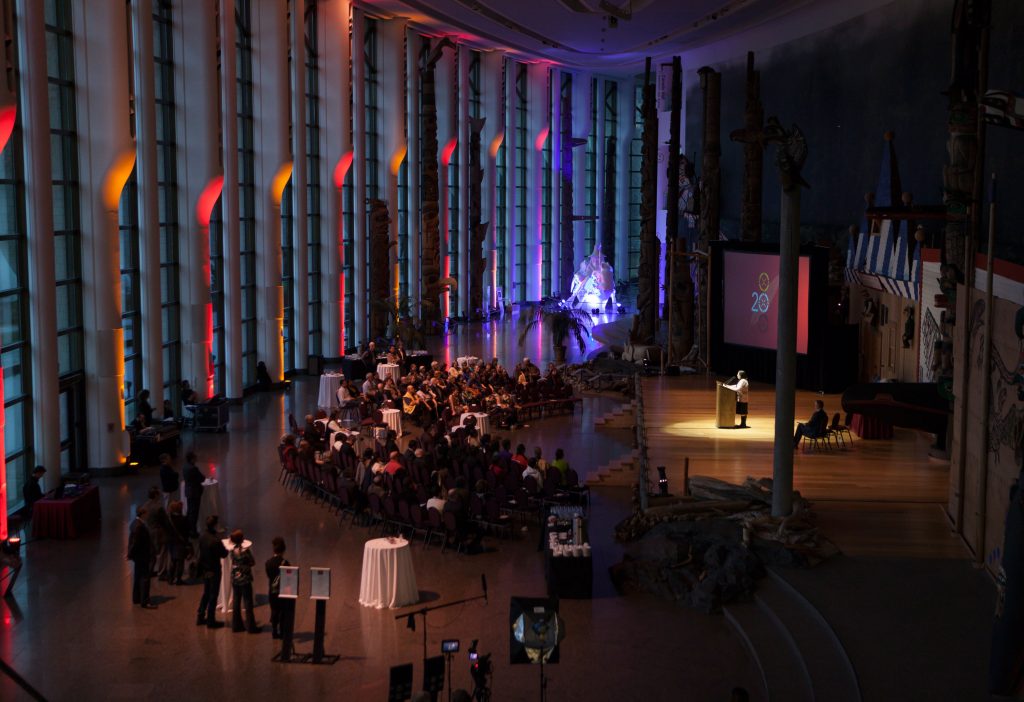
Guest alumna Margaret Fireman (Cree) addresses the attendees at the 20th anniversary graduation ceremony in 2013
Photos
Unique things the Interns find themselves doing:
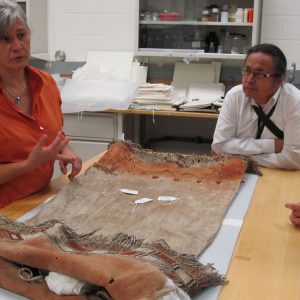 Learning to care for collectionsObjects Conservator Caroline Marchand explains care of collections with Intern Gerald Antoine (Dene), 2012. Photo: Jameson Brant
Learning to care for collectionsObjects Conservator Caroline Marchand explains care of collections with Intern Gerald Antoine (Dene), 2012. Photo: Jameson Brant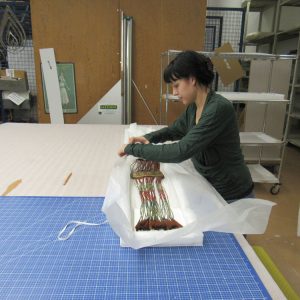 Packing a storage mountKaryne Belanger (Métis) packing a quilled bag in a storage mount she made during her collections placement, 2015. Photo: Penny Pine
Packing a storage mountKaryne Belanger (Métis) packing a quilled bag in a storage mount she made during her collections placement, 2015. Photo: Penny Pine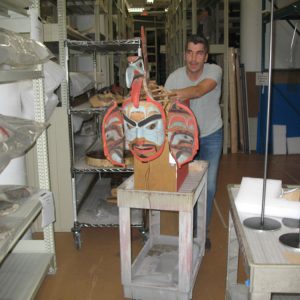 Moving artifacts to prepare an exhibitionPeter Christmas (Mi’Kmaq) moving artifacts in preparation for installation in the Grand Hall, 2012. Photo: Jameson Brant
Moving artifacts to prepare an exhibitionPeter Christmas (Mi’Kmaq) moving artifacts in preparation for installation in the Grand Hall, 2012. Photo: Jameson Brant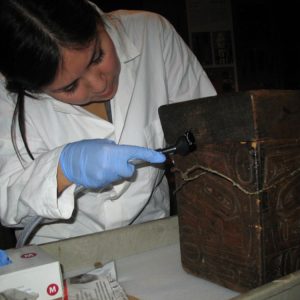 Cleaning a bentwood boxDanielle Printup (Onondaga/Algonquin) cleans a bentwood box in the First Peoples Hall, 2013. Photo: Jameson Brant
Cleaning a bentwood boxDanielle Printup (Onondaga/Algonquin) cleans a bentwood box in the First Peoples Hall, 2013. Photo: Jameson Brant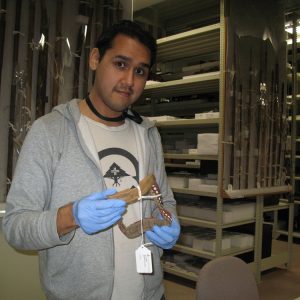 Finding ilgaak (snow goggles) in the collectionStephen Puskas (Inuk) locates ilgaak (snow goggles) he has searched for using the collections database, 2014. Photo: Jameson Brant
Finding ilgaak (snow goggles) in the collectionStephen Puskas (Inuk) locates ilgaak (snow goggles) he has searched for using the collections database, 2014. Photo: Jameson Brant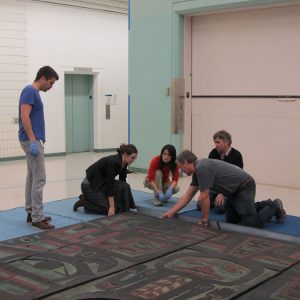 Observing a planning session for large-scale installationIntern Peter Christmas (Mi’Kmaq) observes Exhibition Designer, Conservator, and Preparators as they plan for a large-scale installation in the Grand Hall, 2012. Photo: Jameson Brant
Observing a planning session for large-scale installationIntern Peter Christmas (Mi’Kmaq) observes Exhibition Designer, Conservator, and Preparators as they plan for a large-scale installation in the Grand Hall, 2012. Photo: Jameson Brant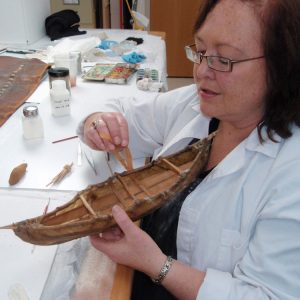 Explaining your conservation-project treatmentIntern Teresa Marshall (Mi’Kmaq) explains her treatment on an assignment in the objects conservation lab, 2008. Photo: Jameson Brant
Explaining your conservation-project treatmentIntern Teresa Marshall (Mi’Kmaq) explains her treatment on an assignment in the objects conservation lab, 2008. Photo: Jameson Brant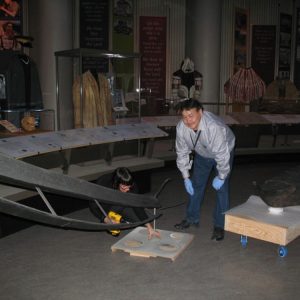 Updating an exhibition installationExhibition Display Preparator Alison Smith-Welsh with Henry Pitawanakwat (Odawa) updating an exhibition installation in the First Peoples Hall, 2014. Photo: Jameson Brant
Updating an exhibition installationExhibition Display Preparator Alison Smith-Welsh with Henry Pitawanakwat (Odawa) updating an exhibition installation in the First Peoples Hall, 2014. Photo: Jameson Brant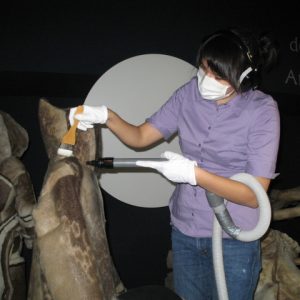 Cleaning a parka in the First Peoples HallDeanna Nebenionquit (Ojibway) cleans a parka in the Arctic section of the First Peoples Hall, 2013. Photo: Jameson Brant
Cleaning a parka in the First Peoples HallDeanna Nebenionquit (Ojibway) cleans a parka in the Arctic section of the First Peoples Hall, 2013. Photo: Jameson Brant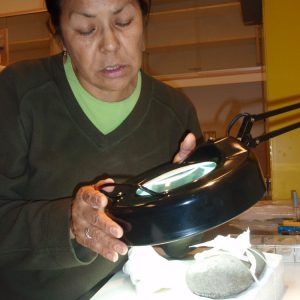 Working on an archaeology-storage projectDorothy Stewart (Cree) works on an archaeology storage project in the collections at the Canadian War Museum, 2009. Photo: Jameson Brant
Working on an archaeology-storage projectDorothy Stewart (Cree) works on an archaeology storage project in the collections at the Canadian War Museum, 2009. Photo: Jameson Brant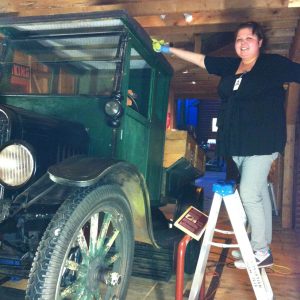 Helping clean inside an exhibitionIntern Angela Lewis (Ojibway) helping to clean in the former Canada Hall, 2014. Photo: Rebecca Renner
Helping clean inside an exhibitionIntern Angela Lewis (Ojibway) helping to clean in the former Canada Hall, 2014. Photo: Rebecca Renner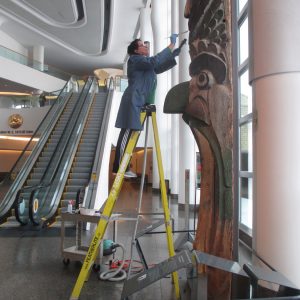 Cleaning a totem poleElizabeth Montour (Mohawk) cleaning a totem pole in the Grand Hall, 2015. Photo: Rebecca Renner
Cleaning a totem poleElizabeth Montour (Mohawk) cleaning a totem pole in the Grand Hall, 2015. Photo: Rebecca Renner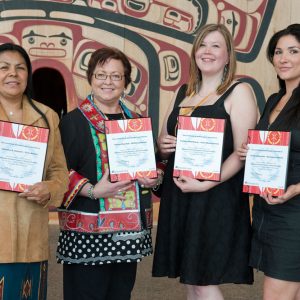 All smiles on graduation dayDorothy Stewart (Cree), Teresa Marshall (Mi’Kmaq), Lindsey Moorhouse (Inuk) and Leslie LeBourdais (Secwépemc) on graduation day, 2009. Photo: Mark Holleron
All smiles on graduation dayDorothy Stewart (Cree), Teresa Marshall (Mi’Kmaq), Lindsey Moorhouse (Inuk) and Leslie LeBourdais (Secwépemc) on graduation day, 2009. Photo: Mark Holleron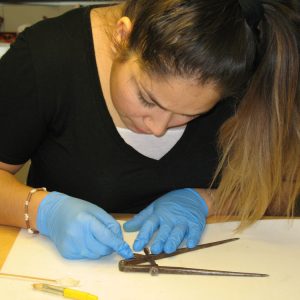 Working on a metal-conservation projectIntern Lydia Mestokosho-Paradis (Innu) working on a metal conservation project, 2016. Photo: Jameson Brant
Working on a metal-conservation projectIntern Lydia Mestokosho-Paradis (Innu) working on a metal conservation project, 2016. Photo: Jameson Brant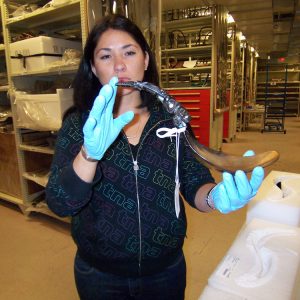 Examining a feast spoonIntern Leslie LeBourdais (Secwépemc) examines a feast spoon in the ethnology collections at the Canadian Museum of History, 2008. Photo: Teresa Marshall
Examining a feast spoonIntern Leslie LeBourdais (Secwépemc) examines a feast spoon in the ethnology collections at the Canadian Museum of History, 2008. Photo: Teresa Marshall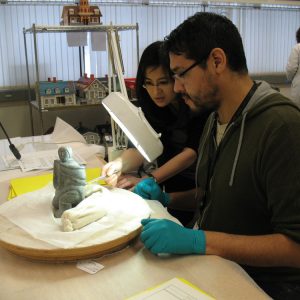 Learning to write condition reportsEmily Lin, Conservator, helps Stephen Puskas (Inuk) learn to write condition reports in the conservation labs at the Canadian Museum of History, 2015. Photo: Rebecca Renner
Learning to write condition reportsEmily Lin, Conservator, helps Stephen Puskas (Inuk) learn to write condition reports in the conservation labs at the Canadian Museum of History, 2015. Photo: Rebecca Renner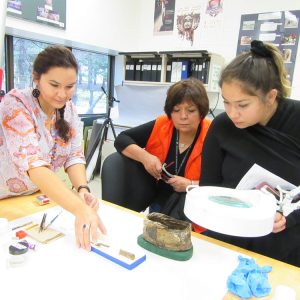 Explaining projects to other InternsAmanda McLeod (Ojibway) explains her archaeology conservation projects to other Interns Charlotte Stringam (Osooyoos) and Lydia Mestokosho-Paradis (Innu), 2015. Photo: Jameson Brant
Explaining projects to other InternsAmanda McLeod (Ojibway) explains her archaeology conservation projects to other Interns Charlotte Stringam (Osooyoos) and Lydia Mestokosho-Paradis (Innu), 2015. Photo: Jameson Brant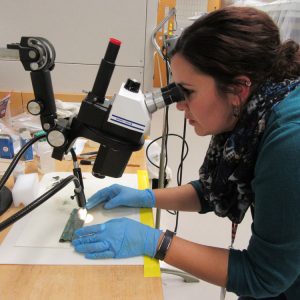 Examining metal deterioration on copperAmanda McLeod (Ojibway) examines metal deterioration on her copper project in the conservation lab, 2015. Photo: Jameson Brant
Examining metal deterioration on copperAmanda McLeod (Ojibway) examines metal deterioration on her copper project in the conservation lab, 2015. Photo: Jameson Brant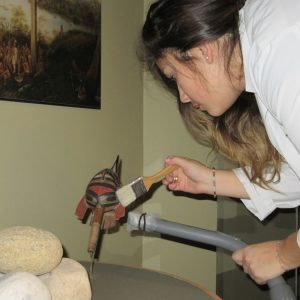 Cleaning a rattleLydia Mestokosho-Paradis (Innu) cleans a rattle on display in the First Peoples Hall, 2016. Photo: Jameson Brant
Cleaning a rattleLydia Mestokosho-Paradis (Innu) cleans a rattle on display in the First Peoples Hall, 2016. Photo: Jameson Brant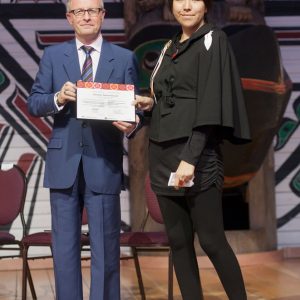 Being celebrated on graduation dayCanadian Museum of History President and Chief Executive Officer Mark O’Neill congratulates graduate Deanna Nebenionquit (Ojibway), 2013. Photo: Perry Zavitz
Being celebrated on graduation dayCanadian Museum of History President and Chief Executive Officer Mark O’Neill congratulates graduate Deanna Nebenionquit (Ojibway), 2013. Photo: Perry Zavitz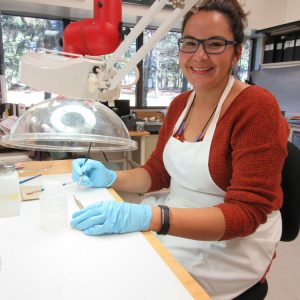 Feeling at home in the conservation labAmanda McLeod, Aboriginal Intern working in the conservation lab at the Canadian Museum of History, 2015. Photo: Jameson Brant
Feeling at home in the conservation labAmanda McLeod, Aboriginal Intern working in the conservation lab at the Canadian Museum of History, 2015. Photo: Jameson Brant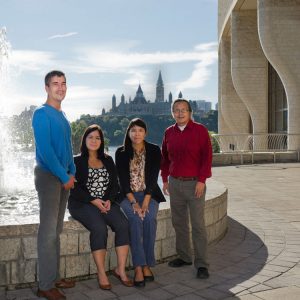 Stopping for a group photoPeter Christmas (Mi’Kmaq), Danielle Printup (Onondaga/Algonquin), Deanna Nebenionquit (Ojibway) and Gerald Antoine (Dene), Aboriginal Training Program in Museum Practices Interns, Fall 2012. Photo: Stephen Darby
Stopping for a group photoPeter Christmas (Mi’Kmaq), Danielle Printup (Onondaga/Algonquin), Deanna Nebenionquit (Ojibway) and Gerald Antoine (Dene), Aboriginal Training Program in Museum Practices Interns, Fall 2012. Photo: Stephen Darby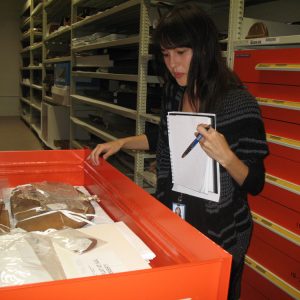 Searching for birchbark in the collectionsKaryne Belanger (Métis) researching in the collections at the Canadian Museum of History, 2014. Photo: Jameson Brant
Searching for birchbark in the collectionsKaryne Belanger (Métis) researching in the collections at the Canadian Museum of History, 2014. Photo: Jameson Brant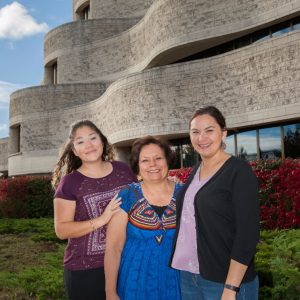 Making new friends with similar goalsLydia Mestokosho-Paradis (Innu) Charlotte Stringam (Osoyoos) and Amanda McLeod (Ojibway), Aboriginal Interns at the Canadian Museum of History, 2015. Photo: Steven Darby
Making new friends with similar goalsLydia Mestokosho-Paradis (Innu) Charlotte Stringam (Osoyoos) and Amanda McLeod (Ojibway), Aboriginal Interns at the Canadian Museum of History, 2015. Photo: Steven Darby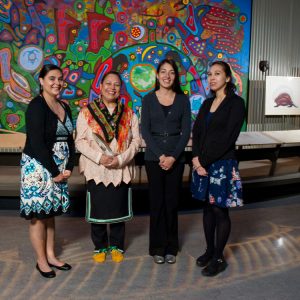 Celebrating a year well worth it!Melissa Phillips (Oneida), Jameson Brant (Mohawk, Coordinator, RBC Aboriginal Training Program in Museum Practices), Virginia Sarazin (Algonquin) and Wahsontiio Cross (Mohawk), Aboriginal Training Program in Museum Practices graduation, Spring 2012. Photo: Steven Darby
Celebrating a year well worth it!Melissa Phillips (Oneida), Jameson Brant (Mohawk, Coordinator, RBC Aboriginal Training Program in Museum Practices), Virginia Sarazin (Algonquin) and Wahsontiio Cross (Mohawk), Aboriginal Training Program in Museum Practices graduation, Spring 2012. Photo: Steven Darby
